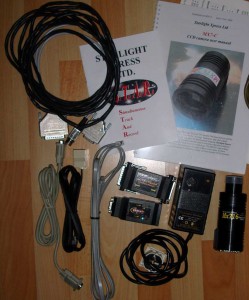Telescopes
The best scope is not necessarily the one with the biggest or most expensive optics – it’s the one you use most often. I had to learn to take the “bigger is better” rule of thumb with a large grain of salt. My big scope has trouble with light pollution in my backyard, and “oh, boy”, I am often to lazy to haul out my 25 kilo equipment for a few hours.
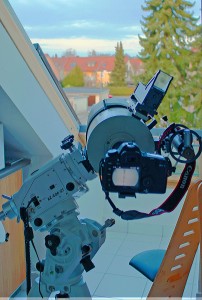 Reflector:As a deep space observer, I got with the ORION UK (203 mm f/6) the biggest size taking in mind weight and light pollution but it is already so big and heavy that I need (mental) strength to move mount and telescope. It is a well-built British made telescope though, designed for Galaxies, Nebulas and indeed allows good views of planets (and of course the moons). I added a used a Bresser GSO 8″ f/4 Newtonian Telescope and Astrograph.
Reflector:As a deep space observer, I got with the ORION UK (203 mm f/6) the biggest size taking in mind weight and light pollution but it is already so big and heavy that I need (mental) strength to move mount and telescope. It is a well-built British made telescope though, designed for Galaxies, Nebulas and indeed allows good views of planets (and of course the moons). I added a used a Bresser GSO 8″ f/4 Newtonian Telescope and Astrograph.-
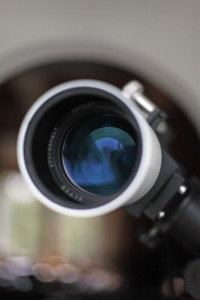 Maksutov: My medium size long focal ratio reflector, Maksutov-Cassegrain INTES 603 (150 mm f/10), will often used with a reducer. The scope looks and feels quite heavy. A dovetail rail is attached to the underside of the scope fits directly to the mount. The finderscope bracket and camera piggy back bracket can both be left on and still fit inside the case. The finderscope adjustment screws have nylon tips to prevent them from damaging the finderscope.
Maksutov: My medium size long focal ratio reflector, Maksutov-Cassegrain INTES 603 (150 mm f/10), will often used with a reducer. The scope looks and feels quite heavy. A dovetail rail is attached to the underside of the scope fits directly to the mount. The finderscope bracket and camera piggy back bracket can both be left on and still fit inside the case. The finderscope adjustment screws have nylon tips to prevent them from damaging the finderscope. - Refractor: My small size refractor TMB 80 (80 mm f/7.5) The Fluorite Triplet Apochromat is regarded as the finest small aperture glass available, is smaller/lighter (APM version), and very well established optic using FPL-53 ED glass. It has a ”dual-speed FeatherTouch” focuser and a retractable dew shield, dust covers. I added a fine 130 mm f/7 Triplet APO – FPL53 with an 2.5 inch RPA focuser. The APO also looks like his “little brother”. The “Business End” of the refractor forms a new “RPA” called 2,5 ” with helical teeth. There is a focusing drive with reduction, a millimeter scale, the focuser is rotatable and offers beside the 2″ connection also an M68 screw thread. What I really liked about this focuser – the clamping. This is a self-centering ring clamp, the eyepiece or whatever is in it is held by compression and nothing can be tilted. Of course, a 130mm triplet lens already means a lot of glass on the front of the tube. The extended metal dew cap does not make the top weight any better. Even my Atik CCD camera with motor driven filter wheel holds too little “weight. Although the tube extends quite on the focuser end, this was never a problem, the APO is never in conflict with the tripod. Optically the 130/910 Triplet APO can keep up with my TMB. So the 130mm f / 7 APO also pleased me very much. A really fine APO equipped with a reasonable focuser. The triplet is needs time at adjust to the tmperature. With high magnifications, the thermal effects are clearly visible, a burst of light away from the star, pointing straight up, where the warm air pulls away. I also found a very strong astigmatism at this time. That does not scare me at first, is more typical for refractors, thermally induced. If the diffraction disk is “decorated” with red and blue edges, the APO is still warm. In fact, the stars became finer over time, the astigmatism fades out. I could not detect any tension, no decentration – as far as everything is ok. Of course, a little time is needed. A fine optic, no doubt about that. Binocular: If my main interest is just cruising star fields or if I use my Fujinon 10×50 FMTR-SX as a spotter for one of my telescopes. My hands down favorite binocular astronomy view is what I see while lying down in my lounge during the summer and looking a little eastward of the zenith soaking in the star rich area around Cygnus/Aquila through my Fujinon 10×50’s.
| ORION UK Newton | TMB 80 Flurite Triplet Apochromat | INTES 603 Maksutov-Cassegrain | |||
| Aperture | 203mm | Aperture | 80mm | Aperture | 152mm |
| Focal length | 1200mm | Focal length | 600mm | Focal length | 1500mm |
| Focal ratio | f/6 | Focal ratio | f/7.5 | Focal ratio | f/10 |
| Primary mirror size | 203mm | Glass | Fully Multicoated | Obstruction | Pyrex 33% |
| Secondary mirror size | 50mm | n/a | n/a | 35 mm | |
| Physics | 8kg / 1139 x 225 | Tube weight | 3kg | Tube weight | 4.8kg |
| Photo Optimized Crayford 1:10 2” | Featherlight 2” | SC 2” | |||
| Bresser PN-203 f/4 Foto-Newton | 130 mm f/7 Triplet APO – FPL53 | ||
| Aperture | 203mm | Aperture | 130mm |
| Focal length | 800mm | Focal length | 910mm |
| Focal ratio | f/4 | Focal ratio | f/7 |
| Primary mirror size | 203mm | Glass | Ohara FPL53 triplet, airspaced Fully Multi Coated |
| Secondary mirror size | 70mm | n/a | n/a |
| Physics | 8.3kg / 1139 x 225 | Tube weight | 10.3kg |
| Focuser | Crayford 1:10 2” | Focuser | 2.5″ RPA Photoline focuser with dual speed |
Mounts
The current mounts I use, are an AZ-HEQ6 and one HEQ5 mount. Both are controlled over WLAN. Sometimes I use a SkyFi box for the AZ-HEQ6 ,but most of the time just amplified USB cables with an hub. SkyFi create its own Ad Hoc. Read more here.
Sky-Watcher AZ-EQ6 SynScan
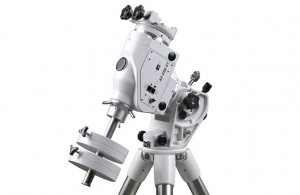 The main mount Sky-Watcher AZ-EQ6 SynScan gives good heavy-duty stability and pointing accuracy. It is a hybrid mount with alt-azimuth capability for general use, and equatorial capability for astrophotography use. Supplied with a SynScan handset with dual AZ/EQ firmware, it can automatically find and track 42,900+ celestial objects from its database.
The main mount Sky-Watcher AZ-EQ6 SynScan gives good heavy-duty stability and pointing accuracy. It is a hybrid mount with alt-azimuth capability for general use, and equatorial capability for astrophotography use. Supplied with a SynScan handset with dual AZ/EQ firmware, it can automatically find and track 42,900+ celestial objects from its database.
This is a still transportable mount for the field weighing only 15 kg, for a load capacity of 20 kg (counterweight excluded). It has a dual-encoder technology which allows the telescope to be moved manually or electronically in either axis without losing its alignment or positional information. After moving to a new object the telescope will automatically begin to track the new object accurately. No re-setup is required in one observing session.
- German Equatorial / Alt-Az dual mode
- Permanent periodic error correction(PPEC). PPEC can be trained with Autoguider or PC.
- Low backlash, silent slewing.
- Includes two dual-fit (45mm/75mm) saddle for mounting two telescopes.
- Polar-alignment with polar-scope.
- DSLR Electronic Shutter Release Port , Autoguider Port
- Alignment methods: 1, 2, or 3 star alignment (EQ) / brightest star or 2 star alignment (AZ)
- 2 x dual-fit saddle plates supplied accepting 45mm & 75mm dovetail bars RA/DEC Worm Gears: D=92.5mm, 180 teeth, brass RA/DEC Axes: D=40mm, steel
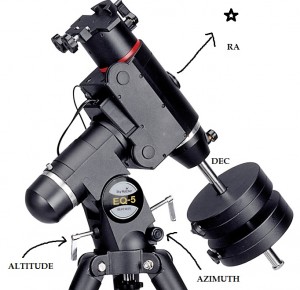 My auxillary HEQ5 mount is fixed in the office. It is a good sturdy mount, good for 12 kg, with both axis motorized. The HEQ5 Standard from Syntia, with its original slow but good DC drive motors is OK for basic tracking I upgraded it with the SynScan GoTo upgrade kit for HEQ5 mounts. The GoTo Upgrade Kit installs more precise stepper motors and adds the Synscan hand controller for better alignment, tracking and location of objects.
My auxillary HEQ5 mount is fixed in the office. It is a good sturdy mount, good for 12 kg, with both axis motorized. The HEQ5 Standard from Syntia, with its original slow but good DC drive motors is OK for basic tracking I upgraded it with the SynScan GoTo upgrade kit for HEQ5 mounts. The GoTo Upgrade Kit installs more precise stepper motors and adds the Synscan hand controller for better alignment, tracking and location of objects.
Besides a fast GoTo system and a connection to the computer using the Ascom Celestron Unified (5.0.30) driver, it has an auto guide port which I have connected via a STAR2000 XPRESS Starlight system and an old fine MX716. The HEQ5 mount is wireless originally via blue tooth and recently self integrated wireless using an USB hub. It’s a Silex USB device server with isochronous data transfer, and USB2Serial Converter. Only power cables go to the mount to the mount.
Manfrotto 055CXPRO4 Carbon Stativ Pro is a reasonable semi-professional tripod specifically designed for extreme outdoor assignments. The legs and the column are made of 100% carbon fiber combined with magnesium die-casting quick action lever locking collars. Each leg can be independently set at four different angle positions. This professional tripod provides great rigidity and lightness, combined with the best professional features such as the patented Q90° center column system. The magnesium top plate integrates a leveling bubble. I use it with an Pro Digital Geared Head Rapid Connect Plate. The 410 Pro Digital Geared Head was good specifically to meet the more exacting, time-sensitive needs of astronomy photographers with payloads up to 7.5 Kg. It utilizes large, easy-to-grip knobs that provide smooth, positive, geared control through 360° pan and +90° -30° frontal and lateral tilt and features instantly disengagement of gears and rough position the camera by hand, then instantly re-engage them for ultra-precise final alignment. I use it when I go backpacking and weight matter just with camera and a a simple nano-tracker and a 50mm an 15 mm lens. In addition I have a Berlebach wooden tripod, which is my favorite (but usually stays in my photo-studio.
My Astro-5 German equatorial mount is one of the better Chinese-made EQ5s out there, if this sample is indicative of the batch. Both the declination and right ascension worm drives must be nicely adjusted. The built-in illuminated polar alignment ‘scope is a nice touch. This mount is quite capable of supporting my Newtonian around 8-inches, certainly my conventional achromatic refractor, and my 6-inches INTES 603 Maksutov-Cassegrain (though the extensible two-piece aluminum tripod will be a bit low).
Communication and Goto
The Skymaster mount is controlled by Tablet (Kindle or my Nexus 5 smartphone) with Skysafari or my Laptops with Ciel 3.8 using Skyfi, over WLAN. The other two mounts use a self-built Littlefoot — basically a poor mans GoTo.
Given there are so many EQ5s out there it was only a matter of time before versatile GoTo upgrade kits would come to fit them all. The Littlefoot includes a rather funky-looking hand controller 12V servo motors for the declination and polar axes, power supply, mounting hardware, cables (including RS232 serial lead. Communication is over serial to USB converter and a Silix printer server to run it over WLAN. Sadly, the Littlefoot will be not supported anymore, by its inventor.
When it comes to alignment of the Littlefoot, you have only one star which assumes that you have a good polar alignment. All told, the pointing accuracy of the Astro-5 combination for stellar and deep-sky objects was pretty good (<0.5° error for targets less than 60° from an alignment object). The pointing accuracy can be significantly improved by ‘syncing’ to a nearby star, then performing a short Go To hop from there. The Sky-Scan is of course in a different league.
Eyepieces
The eyepieces (Zoom have multiple entries)
| Eyepiece | Field | Power | test2 | |||||||
| (mm) | (o) | (X) | D | M | S | |||||
| 4,0 | 50 | 1000 | 00 | : | 03 | : | 00 | Plössel 4 | ||
| 4,0 | 52 | 1000 | 00 | : | 03 | : | 07 | Superplössel 4 | ||
| 6,5 | 50 | 615 | 00 | : | 04 | : | 52 | Plössel 6,5 | ||
| 7,0 | 54 | 571 | 00 | : | 05 | : | 40 | TS Zoom 7-21:7 | ||
| 7,0 | 40 | 571 | 00 | : | 04 | : | 12 | Baader Ortho 7 | ||
| 8,0 | 50 | 500 | 00 | : | 06 | : | 00 | Mark III Hyp:8 | ||
| 12,0 | 54 | 333 | 00 | : | 09 | : | 43 | Mark III Hyp:12 | ||
| 12,5 | 51 | 320 | 00 | : | 09 | : | 33 | Plössel 12,5 | ||
| 16,0 | 58 | 250 | 00 | : | 13 | : | 55 | Mark III Hyp:16 | ||
| 17,0 | 82 | 235 | 00 | : | 20 | : | 56 | Telvue 17 2 Zoll | ||
| 20,0 | 66 | 200 | 00 | : | 19 | : | 48 | TS 20 SW | ||
| 20,0 | 63 | 200 | 00 | : | 18 | : | 54 | Mark III Hyp:20 | ||
| 21,0 | 54 | 190 | 00 | : | 17 | : | 03 | TS Zoom 7-21:21 | ||
| 24,0 | 68 | 167 | 00 | : | 24 | : | 25 | Mark III Hyp:24 | ||
| 25,0 | 55 | 160 | 00 | : | 20 | : | 37 | TAL Plössel 25 | ||
| 32,0 | 67 | 125 | 00 | : | 32 | : | 09 | WA 32 2 Zoll | ||
| 42,0 | 60 | 95 | 00 | : | 37 | : | 53 | WA 42 2 Zoll | ||
| 50,0 | 60 | 80 | 00 | : | 45 | : | 00 | WA 50 2 Zoll | ||
Various filters and a complement of extensions, barlows are used to obtain the desired Field of View on the camera CCDs.
Cameras
Choosing as sensitive camera as possible is a good choice. I already have Starlight Xpress Lodestar X2 B/W which I use for guiding, it is a very sensitive little camera and it works with Starlight Live, so I tried. To make it even easier I acquired the Atik Infinity which I do like and Atik CCD 383 L+. For Planets a low end DMK22 does its job. Last but not least I use a Canon 60Da for astronomy purpose, Canon 5D Mark II for daylight (or night) photography (besides my old Canon 10D).
Lenses
The Canon Lenses (Zoom have multiple entries)


